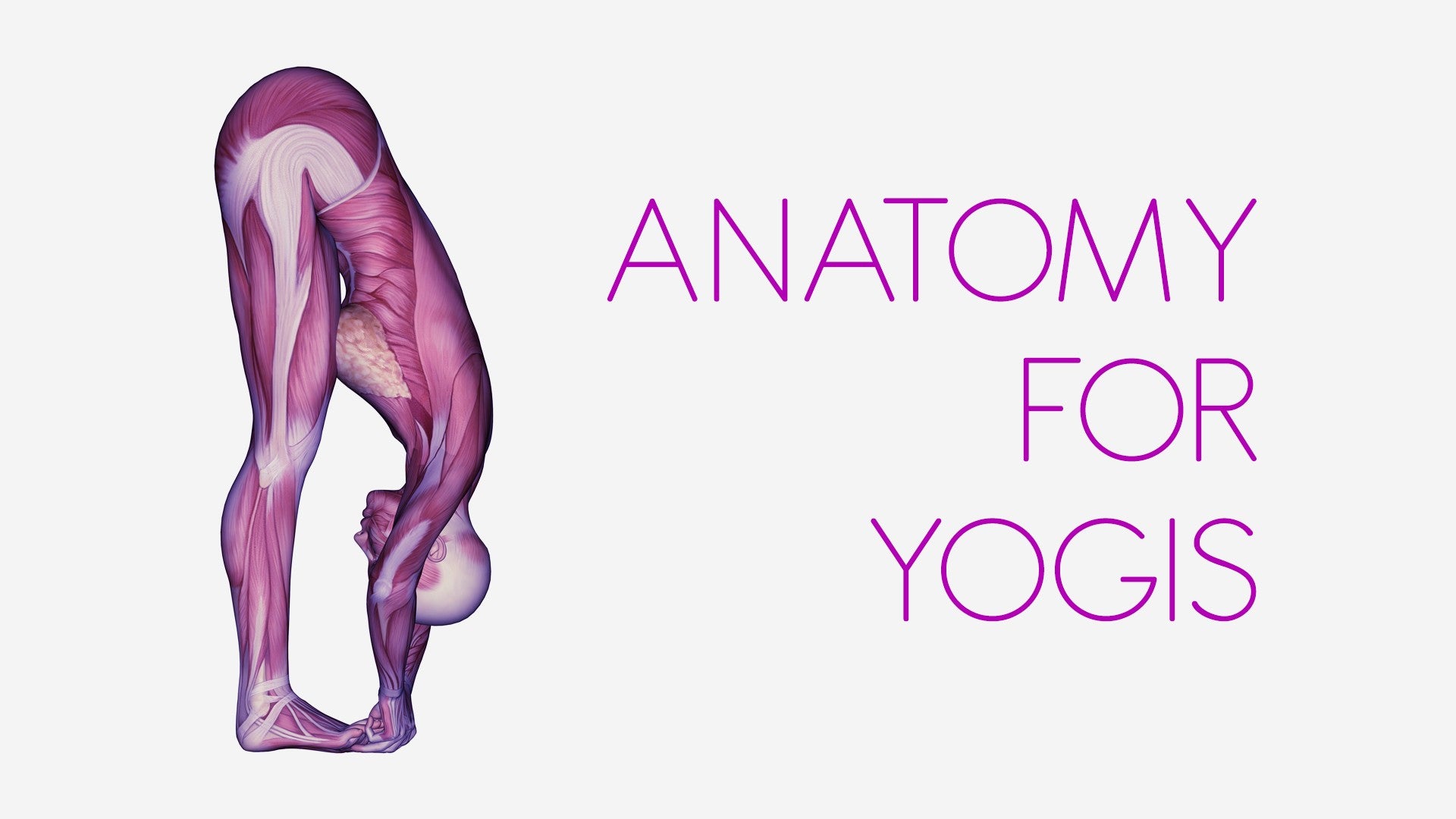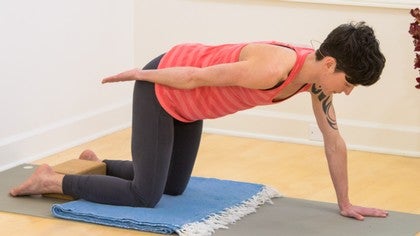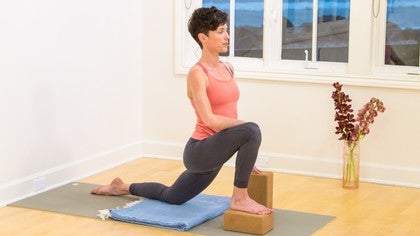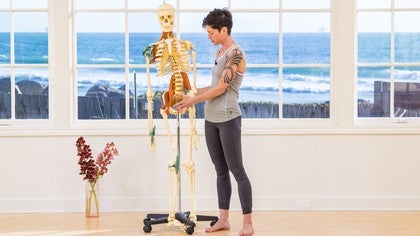Description
About This Video
Transcript
Read Full Transcript
Hey, everyone, welcome back. This sequence will look at deep strength for the arms. This probably goes without saying, but just a reminder that your arms include everything from your shoulders all the way to your hands, and that when you're working with arm strength and particularly weight-bearing on your hands, if anywhere in this continuum isn't online, it's a problem. With hypermobile shoulders, it's really important to have strong hands, and there's actually a really cool explanation for this. There's a number of them, but one explanation that I really like is that when you grew arms back in the day when you were forming as an embryo, when you grew arms, your hands and your shoulders were actually part of the same stuff.
You might remember some of those pictures of early embryonic development and the little kind of C-shaped being with buds, they're called limb buds. They start to come out to the sides, and what starts to come out first are the tips of your fingers, but that tissue as it grows is the same tissue that makes up your shoulder girdle. Eventually you have an upper limb that's made up of a lot of different things, your fingers all the way to your shoulder, but the memory of being the same thing is still there. Structurally, there's still through lines of support from your hands to your shoulder. We can get a lot more intricate of what those through lines are, but for now let's just say that the palm of your hand relates to the inner surface of your shoulder blade, and the dorsal side or the fingernail side of your hand relates to the outer surface of your shoulder blade.
Your thumb has a relationship all the way up towards your collarbone and kind of more of the front side. Your index finger has a relationship to the top of your shoulder, kind of more of the saddle shape between the top of your collarbone and the back of your scapular spine. Your middle finger has a relationship to the center of your shoulder joint. Your fourth finger has a relationship to the armpit side of your scapula, it's called the axillary border, and your little finger has a relationship to the wingtip, I think a lot of times we call them that, the shoulder wingtips or the inferior angle of your shoulder, and then the border of your shoulder blade that's closer to your spine. What we'll start with today is doing some strengthening for the hands, and it's not actually a place where a lot of us think of strengthening very much.
These are tiny, tiny little muscles, they're really close to the joints. Doing this exercise, you'll get tired probably pretty quickly unless you've been doing something similar. My recommendation is to actually, any time you're doing a weight bearing on your hands practice is to start with a couple minutes of this. Here's the exercise. You'll use your thumbs around the tips of your fingers like so, and you're going to do this thing, but you'll listen for it.
You can bring your hands close to your ears, and you want to try and get all four fingers to press out with your thumb, and if you listen, chances are good that one side is quieter than the other, and probably the side that's quieter is your non-dominant hand. You'll want to try and get both sides to be just as loud as each other, and then go as fast as you can. So already my forearms feel tired, I'm going to keep going, it's going to start to feel harder, and let's do this maybe for another 30 seconds or so. I already feel like my fingers are getting sloppy, but that's fine, just keep going, and as you practice, you'll notice that really quickly, actually, you'll start to get more strength, less fatigue in your forearms, let's do 10 more seconds, burning forearms, keep going, five, listening for equal on both sides, two, and one, and then shake out your hands. All right, so lots of strength there, building through the palms, it's called your palmar strength, and then through these muscles in your forearms that you probably start to feel.
Again, you want to work to get a balanced amount of strength between both sides. The next exercise we'll do is at the wall, so I'm going to come and face the wall, and I'll place my hands against the wall about waist height. Now one thing that's important here is that I have flexion through all of my finger joints, so I have the knuckles of my hands where the fingers meet the palm, and then the middle knuckles, so these are the joints between your phalanges, and where I'm placing the weight in my fingertips is right on the top of my finger pads, and if you have long nails, unfortunately this isn't going to work for you, so go cut them off and then come back. So here I want to get my weight to come right through the top of my fingers, and then equal or at least continuous flexion through the length of my fingers, almost like you're making a cage with your hands, and as I push through all ten of my fingers, I get a wrapping of strength around my shoulders, and I'll keep that and let my chest come towards the wall and then back. So I'm doing little finger push-ups here at the wall, and this is a great way to train for Chaturanga, and for those of us with hypermobility in the shoulders, typically what happens, and I'm going to demonstrate this when we do Chaturanga, typically what happens is the shoulders come forwards, so we get too much spreading at the back of the shoulder and then a lot of compression at the front of the shoulder joint and a lack of clarity from the collarbones.
So when I come to the top of my fingers and keep the flexion through all of my fingers, I feel like it's almost like I've got my hands around my shoulder girdle holding from all sides, and I want to think about the centers of my palms lifting away from the wall and the centers of my armpits deepening into my body. So we'll do a couple of reps here, and again, this is a pretty subtle exercise, but it can be tiring pretty fast, and if you're rehabbing your shoulders or if you're training and trying to build good or better movement patterns, this is a great place to stop practicing Chaturanga for a while and come to the wall instead, and again, the smaller muscles, they'll get tired faster, but you can build strength in them fairly quickly. If you do this every day for a week, you'll probably notice a pretty big difference in your arm strength when you're down on the ground. So let's do just a couple more, this little wall push-ups, and as I'm doing these wall push-ups, I'm thinking about keeping the rest of my body aligned as well, so my spine is long and my chest and back are spread, and last one, all right. So from here, we'll come down onto the floor.
I like to have a blanket to support my knees. You might also want to block, we'll be going in and out of table and Virasana. So in Virasana, you'll want to place your block between your heels and sit back like so. All right, so first let's just do hand setup on the floor. When you're weight-bearing on your hands, we'll just come into table to talk about this.
So when you're weight-bearing on your hands, it's important that you're not collapsing through the joints of your hands, again, because the strength of your hands is supporting your wrists, your elbows, and your shoulders. So here I have my hands set up slightly wider than my shoulders, and you might notice that my fingers are spread, but they're not hugely spread, and one thing that I've noticed a lot definitely earlier in my own practice and then seeing a lot of students is this tendency to overspread the pinky finger, and what happens then in this joint, in the base joint of the pinky finger, is that a lot of weight starts to get loaded into it, and if you think about the relationship of the pinky finger into the tip of your shoulder and into the vertical edge of your shoulder blade, when this joint kind of gets blocked, we lose a lot of the strength that's available at that part of the shoulder, and at that part of the shoulder is where we want to get more of this wrapping that a lot of teachers talk about, so you've probably heard teachers talk about triceps towards the floor or the outer shoulder wrapping in. In the hand, it would be this part of the hand, the little finger side of the hand. The little finger side of the hand is also where it's easiest to bear weight first. Sometimes this joint gets really stressed out, and then over time it can lead to dysfunction in the shoulder, so that's my first point for alignment with the hands.
When we come down, again, we'll come down in just a second, if you can just bring kind of like the essence or the feeling of what we did at the wall into your hands and a little bit of a feeling of flexion through all of the knuckles and in the center of the palm. You might have heard in your yoga classes people talk about bandhas. Bandha is a Sanskrit word that oftentimes is translated as a lock or a seal. It's referring to a diaphragm, so a horizontal plane of support, and when you're weight-bearing on your hands, again, if you're collapsed through the palms, then we lose the strength and support that's available all the way upwards into the arms. So creating like a little bit, almost like a suction through the center of your palms and through all of the knuckles of your hands.
All right, so place your hands just a little bit wider than your shoulders. I like to work with a really slight external rotation of my hands. The reason for this for me is that it helps keep my collar wide. Don't turn your hands in. You can see what it does to my shoulders there.
It creates an internal rotation which will create stress through the joint between my acromion and clavicle, it's called the AC joint. All right, so I haven't overstretched my little fingers, and I'm going to start to push down through the finger pads and push down through the base of the knuckles so that I feel the center of the palms and then kind of the arches of my fingers start to lift up. And as I do that, I feel buoyancy through my armpits and similar to at the wall, kind of all the way around my shoulders. Now lastly, I'm going to look down and see that I'm weight bearing evenly between the inner and the outer fingers. So I'm not rolling, tendency is to roll towards the outer fingers, and here I want to push down just as much through the inner edges of the fingers.
I'll feel into my spine here and notice that my spine is more in its neutral curves, so I'm not overtucking my tail, but I feel that there's support wrapping around all sides of my torso. And then from here I'm going to keep my left hand rooting down, and I'll bring my right arm back alongside my body, palm face up towards the ceiling. Now with my left hand, I want to plug in the strength of my hand, elbow, shoulder, right into the core of my body. I want to think about my left ribs really buoyant, my spine supported in my ribs. And then on the right side, I want to feel that the right ribs are also buoyant and that my shoulder is kind of easily resting over the ribs.
And the center of my arm, excuse me, the center of my shoulder is reaching all the way through the center of my middle finger. And then I can rest that hand down, I'm just going to switch sides, grounding down into my right hand, I'll bring my left hand back, repeat all that support from the right hand into the body, left ribs back into the left hand. What I'm looking for here is continuous strength along my tricep, so the backside of my left upper arm from the shoulder all the way to the elbow. And I can feel those muscles gently firming along the length of the bone. I'm looking for a continuous sense of connection and reach from the center of my left shoulder right into the center of my middle finger.
And then we'll bring the left hand down and then go ahead and sit back once again for Virasana. All right, so that strength was working with the back of the shoulder, kind of tricep area. And now we'll just do a little bit to release that. So you can go ahead and take your right arm up, bend your right elbow, and then bring your left hand to your right elbow and really gently pull it back. And then go ahead and switch sides.
So left elbow bends, and now right hand can pull your left elbow back. And here I'm not yanking my elbow back in space. I'm just kind of going right into the edge of sensation. And then we'll release down and come back into your table position. All the same cues with the alignment for your hands and arms.
Same cues with your spine. And on the inhale, this time bring your right arm directly out to the right. Can you find kind of a pathway of support from your left hand to your right hand here? So your left hand is relating to the ground, your left arm is supporting your left ribs, your spine is connected to your left ribs, and then right ribs are supporting your right shoulder. And breathing into the back of the right ribs.
And then we'll exhale and bring the right hand down and just switch sides. So whatever part of your body is relating to the floor, letting that strength come into the parts of your body that are relating to space. And again, this is a pretty simple, maybe even subtle movement. But just holding here will work the smaller, deeper muscles around the joint. So go ahead and take just another full breath in here.
And then when you're ready, let your left hand come down and come back to Virasana. And then to release this part of the shoulder, you can bring your right arm forwards and across your chest. And we'll use the left hand around the elbow. And then I like to think here of my ribs kind of turning to the right as I release from my shoulder blade to my right fingertips. And then we'll switch sides, left arm coming across your chest and releasing from the back of your left shoulder to your left fingers as your ribs turn now to the left.
Okay, all right, so last variation of this shoulder strengthening. Go ahead and come once more into table. Set up your support through your left arm. You're going to keep your head and neck long for this one. The gaze is just slightly forwards of your hands.
And then with your next inhale, bring your right arm forwards. The palm can turn to your midline and the thumb up towards the ceiling. So this one I like to think about just where my spine is in space and feel that my spine is, it's confident in its own length. So my spine is reaching headwards and tailwards. Okay, ribs are buoyant in the back.
And exhale, bring your right hand down. And then we'll switch sides, you can take your left arm forwards. Okay, strongly rooting down through wherever is touching the floor, feeling the support of your legs and your right hand meeting your ribs and the ribs floating up. And then exhale and bring your left hand down. And last time, come back into Virasana.
And then I'm just going to turn so that you can see me. So here I'll bring my right hand behind my back, I'm going to bend my right elbow and grab a hold of my left elbow. And rolling my chin down towards my throat, and then left ear over towards the left shoulder. And I just want to breathe into the right side of my neck. And here you can play a little bit with where you find the most relief.
You might want to nod your nose down towards the floor, further out to the left, maybe a touch up towards the ceiling. Try and relax the weight of your shoulder. And then when you're ready, come back to the center and back up right. And then we'll switch sides so the right hands can come down. And with your left hand, you can grab your right elbow.
And roll your chin down and then right ear to the right shoulder. And just play around with the position of your face. As you turn your face, you'll notice that you have more stretch sensation or more relief through different parts of your neck. And maybe forwards closer to where your jaw connects to your collarbones. And then rolling your chin down towards your throat and releasing from this side.
Right. So you can set your props off to the side. And come back into table. And once again, position your hands so that they're a bit wider than your shoulders. And here we're going to start to really intentionally weight bear through the first knuckles.
So through the base knuckles. More so in the knuckles than in your wrists. So if you think about your wrists getting a little bit lighter. And then casting your weight forwards towards your base knuckles and reaching from the base knuckles through all of your fingertips. Then keep that and come into downward facing dog.
In downward facing dog, you hear a lot of times to press into the L between your thumb and index finger. Knowing what you now know about the relationship of your hand to your shoulder. You can think about the L of your thumb and your index finger supporting the strength of your pectorals and the softness of your collarbones as they reach towards your hands. I like to feel the base of my middle finger is grounding into the floor. And my middle finger is connected to the center of my shoulder joints.
With your next inhale, come forwards for plank. In plank pose, it's the same thing. You want to feel that your weight is moving from the base of your fingers and then reaching forwards into your hands. The very center of your palm is gently lifting. And then release your knees to the floor.
And from here, we'll transition onto our backs. So grab your blanket and you want to fold to support your head on the floor. And I like a three fold for me. We'll start off lying on the left side. And position your blanket so that it supports your head.
And you can just let your left arm come forwards and then bring your right arm on top of it. So one thing just to point out here is that my knees are bent to help me balance here, but I'm not in a fetal shape. My spine is still pretty long. Lift your right hand so that it's in line with your shoulder. And then as you inhale, start to reach your right arm up alongside your ear.
And then back behind you, you can let your torso start to roll open and down towards your hip. Continue at your own pace. You're just making big circles with your right arm. And what I'm looking for here is mobility in my shoulder for sure. I also get a nice kind of opening or stretch through my chest.
But for the purpose of this exploration, what I'm looking for is kind of the container or the boundary of my shoulder joint. And how I'm going to start to look for it is by noticing the places where my shoulder starts to feel a little bit, not stuck, but like right here, I can't continue to go further as my arm is without rotating my palm. So I'd like you to think about the direction of your palm as you make these circles with your arm and just start to play around with turning your palm in space and noticing where the placement of your palm gives you the most ease or feeling of openness through your shoulder. Let's do just a couple more in this direction. And again, you can think about the relationship of the little finger side of your hand into the back of your shoulder, the thumb side of your hand into the front or collarbone portion of your shoulder, and the middle finger into the center of your shoulder.
When you're ready, go ahead and switch directions. So as you explore those relationships, little finger to back of shoulder, thumb to collarbone, middle finger to the center of your shoulder joint. Notice kind of what the difference is in your felt sense, in your felt experience. If you feel those relationships going from shoulder to hand or hand to shoulder, and I'm going to suggest that for those of us who are in tighter bodies, having more tightness in the shoulder, you might find more relief and movement if you think about shoulder to hand and kind of a reaching sensation. And for those of us who are in bodies with looser joints and be hypermobility in the shoulders, you might find more of a sense of sturdiness or awareness in your shoulders if you think of a pathway from hand to shoulder.
So the next time your right hand comes back over your left hand, take a minute there and pause. And then this time we'll come into a twist just to rest for a couple of breaths. So with your inhale this time, take your right fingertips straight up towards the ceiling and watch your hand as it travels all the way back behind you. And let your head turn and your ribs turn. And take a few breaths here.
And then we'll just transition to the second side from here so you can roll through your back and then onto your right side. So again, positioning yourself so that your spine is long. And start with your left hand just hovering above your right. And when you're ready, you can start your windmills making big sweeping circles with your left arm. So we've gone through the connection of hand to shoulder.
And we're exploring a little bit kind of the idea of almost like a current or a flow energetically between your hand and shoulder if you're reaching or if you're kind of curranting in towards your body. And now you can include in all of this exploration your ribs. And just briefly, I'll say that the way that your hands get connected to your spine through your bones is through your ribs. So your collarbone attaches to your breastbone, your breastbone attaches to your ribs, and your ribs attach to your spine. So as your arm moves, can you breathe into your ribs and your spine and let them move as well?
Let's take one more in this direction. And when you're ready, switch directions, go the other way. And the reason why it could be important to think about the ribs here is because the ribs actually form part of the shoulder joint, or the torso has, you know, joints are made by different surfaces of bones articulating with each other. So your shoulder girdle hugs your ribs. And we want to feel that the ribs are in relationship to the shoulder, that that gives the shoulder joint stability and integrity when all parts of it are participating.
You can feel your ribs and your spine also part of this movement. And of course your breath, lots of breath support. The next time your left hand comes over your right, pause for a second, feel the length of your spine, lift your left fingertips all the way up towards the ceiling and follow with your gaze and notice how your gaze and your arm can bring you into your twist. And then when you get there, just rest for a couple of breaths, letting your limbs rest into gravity. And then returning the gaze back to the ceiling and let's transition from here so you can just roll over onto your side and press yourself back up into your seat.
Alright, thanks for joining me for that shoulder strengthening series. I hope you have a really wonderful rest of your day.
Anatomy for Yogis: Renee Sills
Comments
You need to be a subscriber to post a comment.
Please Log In or Create an Account to start your free trial.













